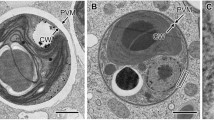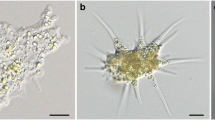Summary
Holmsella australis Noble andKraft ms. is a colourless red algal parasite, forming whitish pustules on its photosynthetic red algal host,Gracilaria furcellata Harvey. In the infected region, host cortical tissue continues to grow and enclose the expanding pustule. Filaments of both host and parasite grow apically, the cells being connected by primary pit connections (PCs). Secondary PCs form between cells of the same species, and in addition,H. australis initiates the formation of secondary PCs with cells ofG. furcellata. All three types of secondary PC are morphologically distinct. In hostparasite PCs the surface adjoining the host cell is similar in structure to a host-host PC, while that adjoining the parasite cell has the structure of a parasite-parasite PC. The plasma membrane is continuous between the cells of the unrelated host and parasite. In addition, a cap membrane is typically produced only on the host surface, though occasionally the parasite side is enclosed by a cap membrane as well. Cap membranes are absent from parasite-parasite PCs (making them intracellular), while host-host PCs are typically extracellular, both cells producing cap membranes. The presence or absence of a cap membrane in certain positions appears to vary, and suggests that cells may be able to regulate its presence. Since transport of nutrients would be expected to occur from host to parasite cells, and between parasite cells, the morphological evidence presented here suggests the PCs may be the pathway.
Similar content being viewed by others
References
Anderson, W. A., André, J., 1968: The extraction of some cell components with pronase and pepsin from thin sections of tissue embedded in an epon-araldite mixture. J. Microscopie7, 343–354.
Duckett, J. G., Buchanan, J. S., Peel, M. C., Martin, M. T., 1974: An ultrastructural study of pit connections and percurrent proliferations in the red algaNemalion helminthoides (Vell. in with) Batt. New Phytol.73, 497–507.
Evans, L. V., Callow, J. A., Callow, M. E., 1973: Structural and physiological studies on the parasitic red algaHolmsella. New Phytol.72, 393–402.
— — —, 1978: Parasitic Red Algae: An Appraisal. In: The Systematics Association Special Volume No. 10—Modern Approaches to the Taxonomy of Red and Brown Algae (Irvine, D. E. G., Price, J. H., eds.), pp. 87–110. London: Academic Press.
Feldmann, J., Feldmann, G., 1958: Recherches sur quelques Floridées parasites. Rev. gen. Bot.65, 49–128.
— —,Guglielmi, G., 1977: Nouvelles observations sur l'ultrastructure des synapses des Rhodophycées. Rev. Algol., N. S.7 (1–2), 11–30.
Goff, L. J., 1976 a: The biology ofHarveyella mirabilis (Cryptonemiales; Rhodophyceae). V. Host responses to parasite infection. J. Phycol.12, 313–328.
—, 1976 b: Solitary bodies (S-bodies) in the Parasitic Red AlgaHarveyella mirabilis (Choreocolaceae, Cryptonemiales). Protoplasma89, 189–195.
—, 1979 a: The biology ofHarveyella mirabilis (Cryptonemiales, Rhodophyceae). VI. Translocation of photoassimilated14C1,2. J. Phycol.15, 82–87.
—, 1979 b: The biology ofHarveyella mirabilis (Cryptonemiales, Rhodophyceae). VII. Structure and proposed function of hostpenetrating cells. J. Phycol.15, 87–100.
—,Cole, K., 1973: The biology ofHarveyella mirabilis (Cryptonemiales, Rhodophyceae). I. Cytological investigations ofHarveyella mirabilis and its host,Odonthaliafloccosa. Phycologia12, 237–245.
— —, 1975: The biology ofHarveyella mirabilis (Cryptonemiales, Rhodophyceae). II. Carposporophyte development as related to the taxonomic affiliation of the parasitic red alga,Harveyella mirabilis. Phycologia14, 227–238.
— —, 1976 a: The biology ofHarveyella mirabilis (Cryptonemiales, Rhodophyceae). III. Spore germination and subsequent development within the hostOdonthalia floccosa (Ceramiales, Rhodophyceae). Can. J. Bot.54, 268–280.
— —, 1976 b: The biology ofHarveyella mirabilis (Cryptonemiales, Rhodophyceae). IV. Life history and phenology. Can. J. Bot.54, 281–292.
Kugrens, P., 1980: Electron microscopic observations on the differentiation and release of spermatia in the marine red algaPolysiphonia hendryi (Ceramiales, Rhodomelaceae). Amer. J. Bot.67, 519–528.
—,West, J. A., 1973 a: The ultrastructure of carpospore differentiation in the parasitic red algaLevringiella gardneri (Setch.) Kylin. Phycologia12, 163–173.
— —, 1973 b: The ultrastructure of an alloparasitic red algaChoreocolax polysiphoniae. Phycologia12, 175–186.
Nonomura, A. M., West, J. A., 1980: Ultrastructure of the parasiteJanczewskia morimotoi and its hostLaurencia nipponica (Ceramiales, Rhodophyta). J. Ultrastruct. Res.73, 183–198.
Peyrière, M., 1976: Étude infrastructurale du plastidome de deux Rhodophycées parasitesHarveyella mirabilis (Reinsch) Schmitz et Reinke etHolmsella pachydema (Reinsch) Sturch. C. R. Acad. Sci. Ser. D283, 1169–1171.
—, 1977 a: Infrastructure des Synapses duGriffithsia flosculosa (Ellis) Batters et de quelques autres Rhodophycées Floridées. Rev. Algol. N. S.7(1–2), 31–43.
—, 1977 b: Ultra-structure d'Harveyella mirabilis (Cryptonemiales, Rhodophycée) parasite deRhodomela confervoides (Ceramiale, Rhodophycée): origine des synapses secondaires entre cellules de l'hote et du parasite et entre cellules du parasite. C. R. Acad. Sci. Ser. D285, 965–968.
Pueschel, C. M., 1977: A freeze-etch study of the ultrastructure of red algal pit plugs. Protoplasma91, 15–30.
Quirk, H. M., Wetherbee, R., 1980: Structural studies on the hostparasite association between the red algaeGracilaria andHolmsella. Micron11, 511–512.
Ramus, J., 1969 a: Pit connection formation in the red algaPseudogloiophloea. J. Phycol.5, 57–63.
—, 1969 b: Dimorphic pit connections in the red algaPseu-dogloiophloea. J. Cell. Biol.41, 340–345.
Richardson, K. C., Jarrett, L., Finke, E. H., 1960: Embedding in epoxy resins for ultrathin sectioning in electron microscopy. Stain Techn.35, 313–323.
Schmitz, F., 1894: Kleine Beiträge zur Kenntniss der Florideen. Nuova Notarisia5, 608–635.
Sturch, H. H., 1924: On the life history ofHarveyella pachyderma andH. mirabilis. Ann. Bot.38, 27–42.
—, 1926:Chloreocolax polysiphoniae, Reinsch. Ann. Bot.40, 585–605.
Wetherbee, R., 1979: “Transfer connections”: specialized pathways for nutrient translocation in a red alga? Science204 (4395), 858–859.
—, 1980: Post-fertilization development in the red algaPolysiphonia. 1. Proliferation of the carposporophyte. J. Ultrastruct. Res.70, 259–274.
—,Kraft, G. T., 1981: Morphological and fine structural features of pit connections inCryptonemia sp., a highly differentiated marine red alga from Australia. Protoplasma106, 167–192.
—,Quirk, H. M., 1982: The fine structure of secondary pit connection formation between the red algal alloparasiteHolmsella australis and its red algal hostGracilaria furcellata. Protoplasma110, 166–176.
—,Scott, F. J., 1980: The fine structure and distribution of “transfer connections” in the red algaPolysiphonia. Micron11, 509–510.
—,Wynne, M. J., 1973: The fine structure of the nucleus and nuclear associations of developing carposporangia inPolysiphonia novaeangliae (Rhodophyta). J. Phycol.9, 402–407.
Author information
Authors and Affiliations
Rights and permissions
About this article
Cite this article
Wetherbee, R., Quirk, H.M. The fine structure and cytology of the association between the parasitic red algaHolmsella australis and its red algal hostGracilaria furcellata . Protoplasma 110, 153–165 (1982). https://doi.org/10.1007/BF01283318
Received:
Accepted:
Issue Date:
DOI: https://doi.org/10.1007/BF01283318




